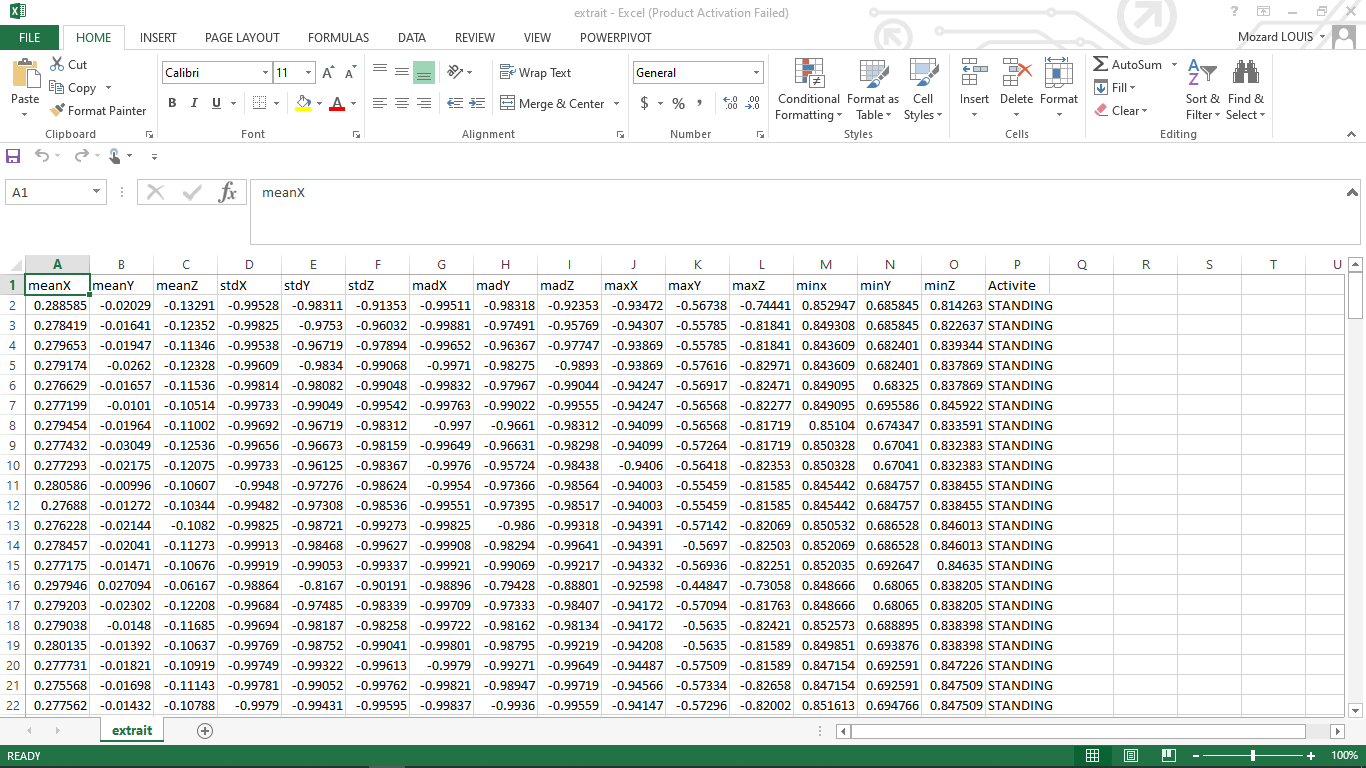This is a dput of an extract of my database. hope it can help
dput(extrait)
structure(list(meanX = c(0.28858451, 0.27841883, 0.27965306,
0.27917394, 0.27662877, 0.27719877, 0.27945388, 0.27743247, 0.27729342,
0.28058569, 0.27688027, 0.27622817, 0.278457, 0.27717497, 0.29794572,
0.27920345, 0.27903836, 0.2801349, 0.27773106, 0.27556818, 0.27756171,
0.27715238, 0.2756763, 0.2792002, 0.28171549, 0.27899267, 0.27573444,
0.14450396, 0.28725164, 0.2799976), meanY = c(-0.020294171, -0.016410568,
-0.019467156, -0.026200646, -0.016569655, -0.01009785, -0.019640776,
-0.030488303, -0.021750698, -0.0099602983, -0.012721805, -0.021441302,
-0.020414761, -0.014712802, 0.027093908, -0.023020143, -0.014800378,
-0.013916951, -0.018210718, -0.016979698, -0.014318487, -0.017983328,
-0.021264234, -0.017714427, -0.011910678, -0.014531029, -0.01801884,
0.18926326, -0.037455064, -0.019484036), meanZ = c(-0.13290514,
-0.12352019, -0.11346169, -0.12328257, -0.11536185, -0.10513725,
-0.11002215, -0.12536043, -0.12075082, -0.10606516, -0.10343832,
-0.10820234, -0.11273172, -0.10675647, -0.061668123, -0.12208028,
-0.11684896, -0.10637048, -0.10918803, -0.11142918, -0.10787724,
-0.10660117, -0.11080122, -0.10916135, -0.10287513, -0.10659617,
-0.10677578, 0.062769317, -0.14597431, -0.10572355), stdX = c(-0.9952786,
-0.99824528, -0.99537956, -0.99609149, -0.99813862, -0.99733496,
-0.99692104, -0.99655926, -0.99732847, -0.99480344, -0.99481511,
-0.99824595, -0.99913488, -0.99918834, -0.98864079, -0.99683904,
-0.99694116, -0.99769492, -0.99749074, -0.99781139, -0.99790424,
-0.99776322, -0.99786211, -0.99838929, -0.99853388, -0.99805969,
-0.99925496, -0.90429967, -0.98291504, -0.99281839), stdY = c(-0.98311061,
-0.97530022, -0.96718701, -0.9834027, -0.98081727, -0.99048681,
-0.96718593, -0.96672843, -0.96124532, -0.9727584, -0.97307692,
-0.98721376, -0.98468004, -0.99052638, -0.8166986, -0.97484812,
-0.98186562, -0.98751567, -0.99322197, -0.9905223, -0.99431129,
-0.98995727, -0.99009076, -0.98730784, -0.98848901, -0.98606983,
-0.99366888, -0.18193654, -0.89160489, -0.94035041), stdZ = c(-0.91352645,
-0.96032199, -0.97894396, -0.9906751, -0.99048163, -0.99542003,
-0.98311783, -0.98158533, -0.98367156, -0.98624387, -0.98535702,
-0.99272659, -0.99627424, -0.99336501, -0.90190653, -0.98338551,
-0.98257653, -0.99040744, -0.99612795, -0.99762104, -0.99595166,
-0.99658567, -0.99459257, -0.99083159, -0.99318367, -0.99342424,
-0.9941888, -0.44315051, -0.94143811, -0.98149266), madX = c(-0.99511208,
-0.99880719, -0.99651994, -0.99709947, -0.99832113, -0.9976274,
-0.99700268, -0.99648525, -0.99759576, -0.99540462, -0.99550927,
-0.99825127, -0.99907654, -0.99921135, -0.98895795, -0.99709389,
-0.99721998, -0.99801432, -0.99790305, -0.99820522, -0.99836517,
-0.99829082, -0.99833345, -0.99886852, -0.99867433, -0.99805916,
-0.99940654, -0.90110019, -0.98441781, -0.99309238), madY = c(-0.98318457,
-0.97491437, -0.96366837, -0.98274984, -0.97967187, -0.99021769,
-0.96609671, -0.96631315, -0.95723623, -0.97366322, -0.97394796,
-0.98599654, -0.98293702, -0.99068725, -0.79428042, -0.97333193,
-0.98161964, -0.98795448, -0.99271072, -0.98946983, -0.99360447,
-0.9896687, -0.98947266, -0.98677131, -0.98854392, -0.98519239,
-0.99362014, -0.11081268, -0.89137296, -0.93692706), madZ = c(-0.92352702,
-0.95768622, -0.97746859, -0.9893025, -0.99044113, -0.9955489,
-0.98311627, -0.98298176, -0.98437928, -0.98564195, -0.98517247,
-0.99318188, -0.99641031, -0.99216753, -0.8880146, -0.98406535,
-0.98133604, -0.99219012, -0.99649182, -0.99719303, -0.99559481,
-0.99670045, -0.99448451, -0.98963739, -0.99328718, -0.99501788,
-0.99358295, -0.40059935, -0.93336072, -0.9806691), maxX = c(-0.93472378,
-0.94306751, -0.93869155, -0.93869155, -0.94246912, -0.94246912,
-0.94098663, -0.94098663, -0.94059758, -0.94002751, -0.94002751,
-0.94390578, -0.94390578, -0.94332286, -0.92597669, -0.9417158,
-0.9417158, -0.94207598, -0.94487012, -0.94566163, -0.94147242,
-0.94147242, -0.94456672, -0.94367519, -0.94255883, -0.94255883,
-0.94288961, -0.93189578, -0.93189578, -0.935389), maxY = c(-0.56737807,
-0.55785126, -0.55785126, -0.57615889, -0.56917385, -0.56568389,
-0.56568389, -0.57263824, -0.56417505, -0.55459369, -0.55459369,
-0.57142214, -0.56970419, -0.56935747, -0.44846574, -0.57093916,
-0.56349958, -0.56349958, -0.57509103, -0.57334183, -0.57295816,
-0.57295816, -0.57528783, -0.56780337, -0.56386922, -0.56386922,
-0.57586911, 0.042098681, -0.49953681, -0.56525476), maxZ = c(-0.74441253,
-0.81840869, -0.81840869, -0.82971145, -0.82470529, -0.82276614,
-0.81718902, -0.81718902, -0.82352693, -0.81585037, -0.81585037,
-0.82069493, -0.82503369, -0.8225147, -0.73057881, -0.81763455,
-0.8242149, -0.81589176, -0.81589176, -0.82658225, -0.82002259,
-0.81751965, -0.81751965, -0.82543702, -0.81539879, -0.81539879,
-0.82266472, -0.3365258, -0.82469972, -0.82253173), minx = c(0.85294738,
0.84930787, 0.84360895, 0.84360895, 0.84909512, 0.84909512, 0.85104022,
0.85032778, 0.85032778, 0.84544241, 0.84544241, 0.85053227, 0.85206858,
0.85203494, 0.84866648, 0.84866648, 0.85257303, 0.84985145, 0.84715408,
0.84715408, 0.85161294, 0.84968627, 0.84968627, 0.85001518, 0.85252893,
0.85044026, 0.85044026, 0.71647623, 0.82636555, 0.84772493),
minY = c(0.68584458, 0.68584458, 0.68240094, 0.68240094,
0.68324978, 0.69558572, 0.67434716, 0.67041013, 0.67041013,
0.68475694, 0.68475694, 0.6865276, 0.6865276, 0.6926473,
0.68064999, 0.68064999, 0.6888947, 0.69387601, 0.69259112,
0.69259112, 0.69476646, 0.68945922, 0.68945922, 0.69190301,
0.69354066, 0.69188515, 0.69127318, 0.65581306, 0.65581306,
0.66274101), minZ = c(0.81426278, 0.82263681, 0.83934417,
0.83786929, 0.83786929, 0.84592156, 0.83359122, 0.83238324,
0.83238324, 0.83845531, 0.83845531, 0.84601343, 0.84601343,
0.8463496, 0.83820463, 0.83820463, 0.83839767, 0.83839767,
0.84722607, 0.84750921, 0.84750921, 0.84986038, 0.84137235,
0.84137235, 0.84726168, 0.84156459, 0.84156459, 0.80898559,
0.80898559, 0.83760928), Activite = c("STANDING", "STANDING",
"STANDING", "STANDING", "STANDING", "STANDING", "STANDING",
"STANDING", "STANDING", "STANDING", "STANDING", "STANDING",
"STANDING", "STANDING", "STANDING", "STANDING", "STANDING",
"STANDING", "STANDING", "STANDING", "STANDING", "STANDING",
"STANDING", "STANDING", "STANDING", "STANDING", "STANDING",
"SITTING", "SITTING", "SITTING")), row.names = c(NA, 30L), class = "data.frame")

